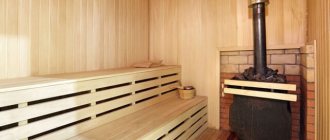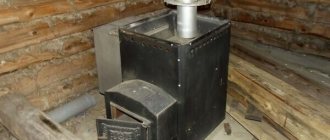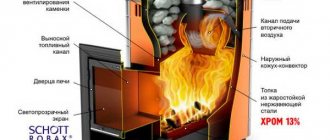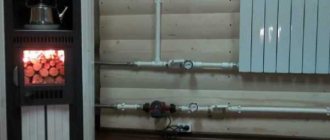Fans of relaxing in a bathhouse or sauna, having their own private house or summer cottage, will sooner or later think about building such a structure on their territory. After all, bath procedures provide an opportunity not only to have a good and fun time with friends, but also to relieve fatigue, improve health and simply relax. First of all, when building a bathhouse, you need to choose the type of stove. You can purchase it ready-made or create it yourself based on a step-by-step assembly algorithm, which will significantly save money.
When choosing ready-made electric stoves for a steam room, first of all, pay attention to the following:
- Optimal level of temperature and humidity;
- Structural integrity;
- Relative indicator of economic efficiency;
- Compliance with the interior of the sauna room.
- Maintaining the interior of the sauna/bath.
What is a heating element of a furnace?
By definition, a tubular electric heater (TEH) is an electric heating device in the form of a metal tube filled with a heat-conducting electrical insulator. Exactly through the center of the electrical insulator (heater core), a conductive nichrome thread of a certain resistance passes to transfer the required specific power to the surface. According to their configuration, heating elements are divided into double-ended (when the contact terminals are located on both sides) and single-ended - with contact terminals located on one side of the heater.
Manufacturing instructions
Making an electric stove for an indoor sauna with your own hands consists of the following steps:
- Development of a detailed drawing on paper with determination of the optimal dimensions, power required for heating, and location of the future device. Typically, the body of an electric furnace is made to be small in volume; the main space in their design is occupied by a basket for stone backfill. The body shape can be any, but a rectangular oven will be more convenient for operation. It is more stable and can maintain its shape for a long period of time. Due to the fact that its corner zones almost never become hot, a balance of heat flows and uniform heating of the room are maintained.
- Calculation of the number of heating elements for the furnace, based on the power of one element.
- Marking body parts on a steel sheet and cutting off the required parts.
- Connecting heating elements into one structure using metal strips.
- Fastening the heating elements on one of the sides. They are mounted to one of the sides of the furnace - side or bottom, using bolts or welding. The distance from the heating elements to the metal walls of the housing must be such that a sheet of asbestos can fit into this gap. Its heat transfer coefficient is minimal, so no heating of the housing directly by the heating elements will occur.
- Furnace body assemblies. Sheet steel parts are fastened by welding or bolts.
- Welding reinforcement legs from the bottom of the furnace body for installation on the floor.
- Laying stones in dense layers, without gaps or large cracks. Larger stones are placed at the bottom, and then smaller fractions. There should be a small gap between the heating elements and the filler for air convection; the last row of it should completely cover the heating element, but not be higher than 8 cm. When laying stones, the heating elements must be held.
- Making a protective casing for the furnace from sheet steel or fireclay bricks.
- Installation of power tools in the oven. For this stove, a simple circuit diagram is taken as a basis: voltage from the network is supplied to the terminals of the remote control controller, and the wires coming from the heating apparatus are connected to the output terminals.
- Installation of the furnace control panel. The steam room maintains a high level of temperature and humidity, so the remote control should be installed on the wall in another room, where the temperature is not higher than 25 - 28 degrees. The wires from the control panel must be connected to a separate circuit breaker in the electrical panel and laid in protective corrugated sleeves. Previously, special grooves are punched in the walls for wiring, which, after installing the wires, are sealed with non-flammable building materials, for example, a cement-sand mixture.
- Installation of temperature and humidity control sensors for an electric oven. To connect them, heat-resistant cables are used, one-piece in length, without joints. Usually they are mounted on top of the unit, above the shelves or above the entrance door to the steam room.
- Ground loop devices. The electric stove must be connected to the line of its own grounding loop, which is recommended to be laid in the ground during the construction of the sauna. It is connected to the furnace using protective cable channels. If you didn’t worry about grounding at the time, then the grounding cable of the stove must be connected to the neutral terminal of the electrical panel.
- Installation of a thermostat. It is installed inside the structure and is used to measure and adjust the heating temperature of the stones.
- Improvement of the appearance of the stove. The body parts are cleaned with sandpaper, degreased with gasoline or acetone, primed and painted with two layers of heat-resistant paint;
- Checking the operation of the oven, installation safety and connection.
How are heating elements used for saunas?
Any tubular electric heater is designed to heat and maintain a constant temperature in a liquid or gas by convection, conduction and radiation. Today, all electric sauna heaters use heating elements as heating elements! All manufacturers - Harvia, Helo, Sawo, Tylo, etc. – they produce their heaters both as part of the furnaces themselves and in the form of spare parts. Mainly, electric ovens use the property of convection: cold air is captured from below, releasing a hot stream upward. There are exceptions: thermos stoves and heaters, where heating elements are tightly lined with stones, use thermal conductivity, and, for example, TYLO models with open electric heaters actively use radiation from the elements for the fastest heating.
About the future design
Construction of a homemade electric stove for a sauna
The simplest model of an electric stove consists of a box-shaped body, inside of which there is a tank with a door on the neck for adding water and several heating elements welded together. Stones are laid on top and between them. When heated, the stones release thermal energy into the steam room, raising the temperature in it to the optimal level.
For metal structural elements, stainless steel is used, which does not corrode in water, does not burn out under high temperatures and does not emit harmful substances.
If possible, the device is controlled by an electronic remote control, which should be located outside the steam room. It is connected to the furnace heating unit with an electric cable.
The heating system is activated by turning on the timer. The maximum permissible heating level for heating elements is 650ºС. If the temperature drops to 600ºC, the sensor is triggered and the “Heating” light comes on. The stones are heated when the timer is in standby mode.
As soon as the top layer of stones heats up to 550ºC, the timer is triggered and the light turns on in the “Ready” position.
Stones can also be placed on top of the body above the heating elements on a metal grid welded from reinforcement and during bath procedures, water them or herb infusion to create steam.
What types of tubular electric heaters exist, and how do some differ from others?
There are a huge variety of tubular electric heaters; it makes no sense to talk about the entire classification. Electric heaters use double-ended heating elements with contact leads located on both sides. Heating elements of furnaces are divided into straight and oblique. For straight lines, the exits are directed downwards parallel to the turns of the spiral, and for oblique ones - to the side, perpendicular to the turns. Heating elements from different companies differ: in power, in length, in configuration, in fasteners, in the shape of the landing leads. You should always remember this when choosing replacement elements!
Materials
To make an electric sauna stove with your own hands, you will need to purchase the following materials:
- several electric heating elements (3-4 pcs.);
- stainless steel sheets with a thickness of at least 3 mm;
- fittings with a diameter of 6 - 10 mm;
- power cable;
- rheostat that regulates power;
- temperature sensor;
- asbestos cement slab;
- a can of heat-resistant paint;
- backfill made of stone.
Main types of electric furnaces
- Classic steam room oven
is a massive device designed to heat liquids and stones. This category of stoves has a lot of weaknesses related mainly to ease of use. The brick structure must be installed on a special foundation. All safety and maintenance measures must be followed. Brick laying must be done by a professional stove maker. Firewood will be used as a fuel source. Classic stoves have a large heat capacity, so reaching operating temperature takes a lot of time. A brick stove must have ventilation holes and a chimney, which must be cleaned periodically.
- Metal furnaces
. This is not such a bulky type of oven as brick ones. Such stoves (potbelly stoves) are made from sheets of metal and their weight is much less than that of brick ones. Firewood is also used as fuel. But a special foundation for pouring is not required, which is also an advantage. It is enough to install a pedestal up to 20 centimeters high.
- Electric furnaces
Excellent for heating small baths and saunas. The installation takes up little space and does not require special care. Electric furnaces are also easy to operate. There is no need for a chimney. Heating is provided by tubular electric heaters - heating elements.
For electric heaters, you can use different types and configurations of heating elements. They must be characterized by reliability at high operating temperatures and high humidity. The outer shell of the heater must be made of stainless metal that is resistant to oxidation and moisture. The electric heater flange is secured by welding. Soldering is not suitable in this case. Tekhnonagrev produces heating elements for electric heaters of any complexity from high-quality materials.
Installation Requirements
The safest place to place an electric furnace is the corner closest to the front door. You can also install it in the center, but be sure to comply with the following requirements:
- the presence of a gap between the hot surfaces of the stove and the walls of the steam room;
- Highly flammable surfaces are protected with a special screen;
- protective fences have been installed with a gap between them and the stove measuring 7 cm or more, which will help to avoid severe burns on the skin in case of accidental contact;
- There should be an inlet for the ventilation system behind the stove. It should be through and located at a height of 7 - 10 cm from the floor level. The size of the hole depends on the power of the oven, on average its diameter is 15 - 25 cm;
- a massive support for such a heating device is not needed, however, several layers of fireclay bricks still need to be placed under the installation of the product. A thick sheet of metal with a backing made of heat-insulating material, for example, slabs of extruded polystyrene foam or fiberglass wool, is also suitable for these purposes;
- for a small electric furnace, it is enough to place an asbestos-cement slab or ceramic products on the floor.
Why is it worth choosing an electric heater for a bath?
Electric heaters have a number of advantages and have proven themselves in practice. Let's consider each of the advantages of the heater separately:
- Room heats up pretty quickly
compared with other types of heating structures.
- Selected the temperature remains for a long time
.
- Due to the use of electric heaters as a heating source no need for a chimney
. For the same reason, ash and other deposits do not form inside the unit, which would have to be periodically cleaned. A ventilation system is also not needed.
- No special maintenance required either
. There is no need to clean out the soot. To operate, you only need an electrical outlet. Connect the network and select the desired temperature mode.
- It is easy to regulate the operation of the electric heater
. The thermostat is located inside the sauna room. The temperature can be constantly maintained or changed in a controlled manner throughout the entire process of using the bath. Fuses eliminate the risk of overheating.
- High level of operational safety
. The electric furnace does not produce carbon monoxide, which eliminates the risk of poisoning. Due to the absence of an open flame, ignition of wooden surfaces and elements of the bathhouse is impossible.
- Small dimensions
stoves allow it to be installed in small spaces. There is no point in installing a foundation. The use of a compact pedestal will be sufficient. For protection, lay out a brick partition.










